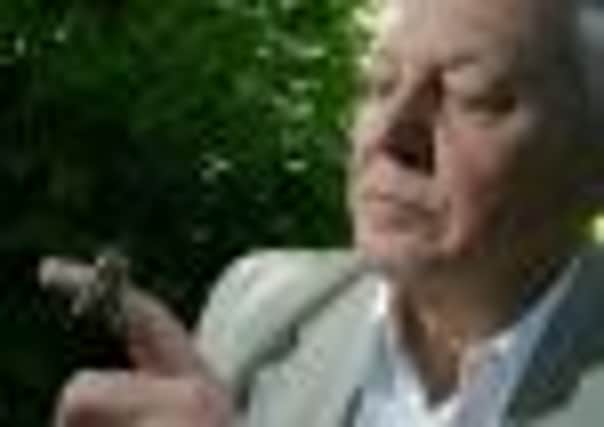Flight and darkness


A small group huddle together in the gloom, their heads bowed as they stare intently into a spear of light from a dark object at their feet.
This is not a re-enactment of an alien invasion film, this is the world of the moth enthusiast. The onlookers watch bewitched as scores of moths are lured in by the blinding glow of a light trap – a wooden box fitted with a mercury vapour bulb that emits ultra-violet light.
Advertisement
Hide AdAdvertisement
Hide AdIn the days before the light bulb, “sugaring” was one of the field methods for luring moths. Everyone had their secret recipe of beer, sugar and rotten fruit, claiming theirs attracted the most moths.


Nowadays, wine-roping with a wine/sugar mix is more common than traditional sugaring methods. The trap is just one weapon in the armoury of the “mother”. Another approach is to hang up white blankets illuminated by lantern light – the lamp and sheet trap.
Scientists believe moths are not actually “attracted” to light, trying instead to fly away from artificial light. However, no one yet has managed to prove scientifically what actually happens when moth meets light.
Moths are crucial indicators of the state of the health of our environment. Not only do they pollinate some of our rarest wild flowers, their larvae are a very important food source for the wild birds of Britain; an estimated 35 billion moth larvae are consumed by blue tits alone in the UK.
Advertisement
Hide AdAdvertisement
Hide AdBut through the centuries moths have been blamed for a litany of sins. They get an early and unfavourable mention in the Bible for eating precious cloth. Through the medieval period they were seen as harbingers of death or the spirits of witches.


Today the diminutive Brown-tail has been depicted by some parts of the media as a rampaging super-caterpillar, capable of inflicting bouts of itching and the cause of respiratory problems.
That moths should come under fire is bad new given that the moth population is now in catastrophic decline. Some 60 of our 2,500 moth species became extinct in the last 100 years. Many more are in danger of heading the same way due to climate change, habitat loss and changes in agriculture.
What of the moths that are supposed to be a problem for humans? Three species of clothes moths found in the UK will nibble on natural fibre garments. But as moth larvae (caterpillars) are attracted to traces of sweat and food stains, they will only tuck in to your clothes if they have not been washed properly.
Advertisement
Hide AdAdvertisement
Hide AdIt’s true the Brown-tail moth sheds fine hairs that can cause skin irritation. But this is simply a defence mechanism, not a deliberate show of aggression.
Only four out of 2,500 species pose any kind of problem, yet negative associations still abound. The macabre reputation is in some way understandable. Moths appear, fluttering and wraithlike, as night descends, seemingly hell-bent on self-destruction as they hurtle towards the glow of a candle.
One of our super-moths, the Death’s-head Hawk-moth, has been painted as responsible for this sinister stereotype. This moth (which can squeak) is huge – comparable in size to our smallest birds – and its dark, furry thorax is decorated with a striking skull-like marking. In the film The Silence Of The Lambs the serial killer main character places a pupa of a variant of the moth in his victims’ mouths.
The Victorian painter William Holman Hunt painted The Hireling Shepherd in 1851. It seems at first glance to be a celebration of the rural idyll where a shepherd sits with his true love in a sunlit pasture offering her a token of his affection.
Advertisement
Hide AdAdvertisement
Hide AdBut the gift is a Death’s-head Hawk-moth. Closer inspection of the scene reveals some of the flock have strayed into a wheat field, others seem unable to get up and a lamb on the girl’s knee is eating green apples which will make it ill.
Less sinister is the Hummingbird Hawk-moth, which can rightly lay claim to the title of the UK’s most spectacular insect. This migrant hovers more or less like a hummingbird above the flower beds and brings an unexpected touch of tropical glamour to our summer gardens.
Some moths are difficult to identify. One species is named “Uncertain” while another enjoys the title “Confused”. One of the joys of “mothing” is entering the world created by the Victorian collectors who were responsible for naming many of our moths such as the Geometrician, the Sorcerer, the Vapourer and even the Setaceous Hebrew Character.
Les Hill, a moth expert at Butterfly Conservation which runs the National Moth Recording Scheme, acknowledges moths still have an image problem.
Advertisement
Hide AdAdvertisement
Hide Ad“It is very frustrating to see the bad press moths receive,” he says. “Usually as either jumper-munching pests, or for spinning unsightly larval webs or even flying indoors around light fittings.
“This is mainly because moths generally fly at night and are perceived by the public as scary and vampire-like.
“Also, phrases like ‘moth-eaten’ are still used in everyday language as an analogy for anything that looks like it may have been nibbled on.
“Historically, people wore natural fibres only, therefore the abundance of ‘clothes’ moths was far greater than it is today and it was perceived that all moths ate clothes.”